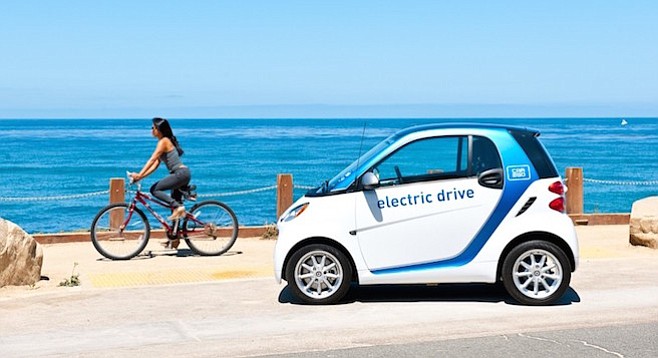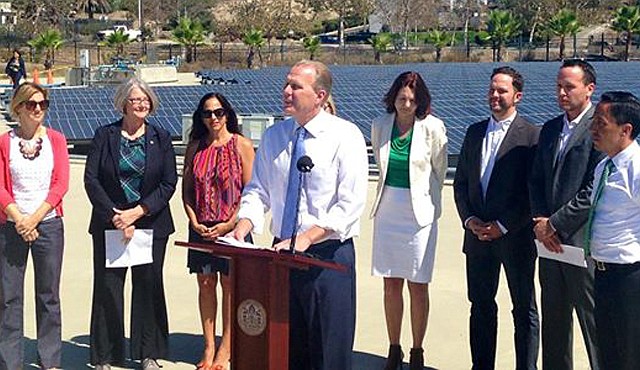 Facebook
Facebook
 X
X
 Instagram
Instagram
 TikTok
TikTok
 Youtube
Youtube

Local economic and political powers, including UCSD and Sempra, have been spending big bucks touting San Diego as a haven for electric cars, with Republican mayor Kevin Faulconer leading the PR parade.
"Smart Cities San Diego is committed to helping San Diego become America’s Finest ‘Plug-In’ Ready City by facilitating the expansion of a public electric vehicle infrastructure that ensures the safe, reliable, and efficient integration of EV charging loads with the power grid," says the website of CleanTech San Diego, a nonprofit whose boardmembers include representatives of Sempra-owned San Diego Gas & Electric, UCSD, Qualcomm, and the mayor.
"As of early 2015, the region has 14,000 EV drivers, 727 public charging stations, and 34 DC fast chargers. San Diego is also home to car2go’s fleet of 400 electric vehicles, the only all-electric car sharing program in North America."

Faulconer's high-profile "Climate Action Plan" hinges on a scheme to have a reported 50 percent of city vehicles powered by electricity by 2020 and 90 percent by 2035. New buildings would also be required to install conduits for electric vehicle charging stations.
“San Diego is a city that innovates. We are a city that leads. We are a city where our environment is central to our quality of life,” Faulconer said in a September speech that launched the plan.
But what if too many electric vehicles get plugged in at once? Despite the mayor's heavy-duty public relations pitch, there are some significant glitches in the grid remaining to be dealt with.
The untold story is revealed by an April report from the Idaho National Laboratory, which runs the federal Department of Energy’s Advanced Vehicle Testing Activity program.
"The power required to recharge a [plug-in electric vehicle] can be a significant contributor to the electrical load a residence places on the electric grid and, specifically, on the local residential power transformer providing energy to several nearby homes," according to the laboratory's San Diego study, conducted during three months in 2013.
"Two neighbors simultaneously charging [plug-in electric vehicles] have shown a power demand nine times that of the typical San Diego residential power demand," the report says.
Concerned by the unprecedented amounts of electricity drawn by multiple plug-ins, called "clusters," investigators looked into the "impact to the local electrical distribution system and, in particular, the local residential electrical transformer."
The lab's conclusion: "Higher than originally anticipated loads on this transformer can lead to damage, local power outages, and higher costs to the electric utility for replacement equipment."
The study explains that "While the transformer typically can accept the power demand increase from one [plug-in electric vehicle], multiple [vehicles] charging simultaneously may cause damage to the transformer, resulting in a service outage and the need to replace the transformer."
According to the document, "Damage caused by overloading the transformer may occur in the short term for significant overloads or in the longer term by depriving the transformer of its normal cool-down period, typically occurring in the early morning hours."
In addition, the study says, the region’s utility system does not have the transformer capacity found elsewhere.
"The mild climate of San Diego leads to relatively small typical household loads, allowing smaller capacity neighborhood transformers or many houses being fed by the same transformer."
Though the public is in the dark, SDG&E is well aware of the problem, the report says. "At this writing, the utility has, in fact, replaced a few transformers linked to cluster effects."
So far, "While SDG&E is monitoring and testing some neighborhood transformers where [plug-in electric vehicles] charging occurs, the low impact experienced thus far from the relatively small population of [electric vehicle] owners has led to a reactive strategy (i.e. replacing the transformer should a problem arise)."
But accelerating use of electric vehicles, as promoted by the mayor, his political backers at Sempra, and other local high-tech boosters, could result in widespread blackouts or require new cost-boosting grid makeovers that have yet to be widely acknowledged.
"As adopters demand greater vehicle range and shorter charge times, the vehicle battery capacity is likely to increase, along with the capability for higher charging power," notes the report.


Local economic and political powers, including UCSD and Sempra, have been spending big bucks touting San Diego as a haven for electric cars, with Republican mayor Kevin Faulconer leading the PR parade.
"Smart Cities San Diego is committed to helping San Diego become America’s Finest ‘Plug-In’ Ready City by facilitating the expansion of a public electric vehicle infrastructure that ensures the safe, reliable, and efficient integration of EV charging loads with the power grid," says the website of CleanTech San Diego, a nonprofit whose boardmembers include representatives of Sempra-owned San Diego Gas & Electric, UCSD, Qualcomm, and the mayor.
"As of early 2015, the region has 14,000 EV drivers, 727 public charging stations, and 34 DC fast chargers. San Diego is also home to car2go’s fleet of 400 electric vehicles, the only all-electric car sharing program in North America."

Faulconer's high-profile "Climate Action Plan" hinges on a scheme to have a reported 50 percent of city vehicles powered by electricity by 2020 and 90 percent by 2035. New buildings would also be required to install conduits for electric vehicle charging stations.
“San Diego is a city that innovates. We are a city that leads. We are a city where our environment is central to our quality of life,” Faulconer said in a September speech that launched the plan.
But what if too many electric vehicles get plugged in at once? Despite the mayor's heavy-duty public relations pitch, there are some significant glitches in the grid remaining to be dealt with.
The untold story is revealed by an April report from the Idaho National Laboratory, which runs the federal Department of Energy’s Advanced Vehicle Testing Activity program.
"The power required to recharge a [plug-in electric vehicle] can be a significant contributor to the electrical load a residence places on the electric grid and, specifically, on the local residential power transformer providing energy to several nearby homes," according to the laboratory's San Diego study, conducted during three months in 2013.
"Two neighbors simultaneously charging [plug-in electric vehicles] have shown a power demand nine times that of the typical San Diego residential power demand," the report says.
Concerned by the unprecedented amounts of electricity drawn by multiple plug-ins, called "clusters," investigators looked into the "impact to the local electrical distribution system and, in particular, the local residential electrical transformer."
The lab's conclusion: "Higher than originally anticipated loads on this transformer can lead to damage, local power outages, and higher costs to the electric utility for replacement equipment."
The study explains that "While the transformer typically can accept the power demand increase from one [plug-in electric vehicle], multiple [vehicles] charging simultaneously may cause damage to the transformer, resulting in a service outage and the need to replace the transformer."
According to the document, "Damage caused by overloading the transformer may occur in the short term for significant overloads or in the longer term by depriving the transformer of its normal cool-down period, typically occurring in the early morning hours."
In addition, the study says, the region’s utility system does not have the transformer capacity found elsewhere.
"The mild climate of San Diego leads to relatively small typical household loads, allowing smaller capacity neighborhood transformers or many houses being fed by the same transformer."
Though the public is in the dark, SDG&E is well aware of the problem, the report says. "At this writing, the utility has, in fact, replaced a few transformers linked to cluster effects."
So far, "While SDG&E is monitoring and testing some neighborhood transformers where [plug-in electric vehicles] charging occurs, the low impact experienced thus far from the relatively small population of [electric vehicle] owners has led to a reactive strategy (i.e. replacing the transformer should a problem arise)."
But accelerating use of electric vehicles, as promoted by the mayor, his political backers at Sempra, and other local high-tech boosters, could result in widespread blackouts or require new cost-boosting grid makeovers that have yet to be widely acknowledged.
"As adopters demand greater vehicle range and shorter charge times, the vehicle battery capacity is likely to increase, along with the capability for higher charging power," notes the report.
Comments